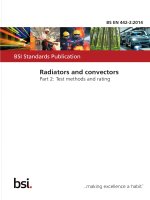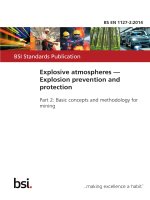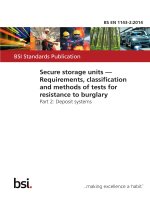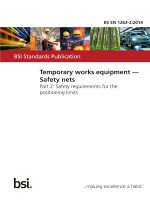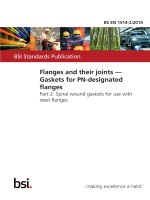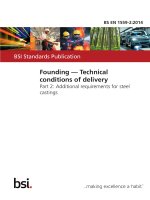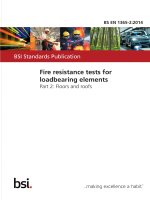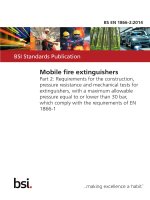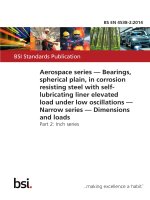Bsi bs en 16185 2 2014
Bạn đang xem bản rút gọn của tài liệu. Xem và tải ngay bản đầy đủ của tài liệu tại đây (1.3 MB, 64 trang )
BS EN 16185-2:2014
BSI Standards Publication
Railway applications — Braking
systems of multiple unit trains
Part 2: Test methods
BRITISH STANDARD
BS EN 16185-2:2014
National foreword
This British Standard is the UK implementation of EN 16185-2:2014.
The UK committee draws users’ attention to the distinction between
normative and informative elements, as defined in Clause 3 of the
CEN/CENELEC Internal Regulations, Part 3.
Normative: Requirements conveying criteria to be fulfilled if
compliance with the document is to be claimed and from which no
deviation is permitted.
Informative: Information intended to assist the understanding or use
of the document. Informative annexes do not contain requirements,
except as optional requirements, and are not mandatory. For
example, a test method may contain requirements, but there is no
need to comply with these requirements to claim compliance with
the standard.
When rounded values require unit conversion for use in the UK,
users are advised to use equivalent values rounded to the nearest
whole number. The use of absolute values for converted units should
be avoided in these cases. For the values used in this standard:
INS, RST and ENE speed conversions
km/h
mph
2
1
3
1
5
3
10
5
15
10
20
10
30
20
40
25
50
30
60
40
80
50
100
60
120
75
140
90
150
95
160
100
170
105
180
110
190
120
200
125
220
135
225
140
230
145
250
155
280
175
300
190
BRITISH STANDARD
BS EN 16185-2:2014
INS, RST and ENE speed conversions
km/h
mph
320
200
350
220
360
225
The UK participation in its preparation was entrusted by Technical
Committee RAE/4, Railway Applications - Rolling stock systems,
to Subcommittee RAE/4/-/1, Railway applications - Braking.
A list of organizations represented on this subcommittee can be
obtained on request to its secretary.
This publication does not purport to include all the necessary
provisions of a contract. Users are responsible for its correct
application.
© The British Standards Institution 2015. Published by BSI Standards
Limited 2015
ISBN 978 0 580 69063 1
ICS 45.040
Compliance with a British Standard cannot confer immunity from
legal obligations.
This British Standard was published under the authority of the
Standards Policy and Strategy Committee on 31 January 2015.
Amendments/corrigenda issued since publication
Date
Text affected
BS EN 16185-2:2014
EN 16185-2
EUROPEAN STANDARD
NORME EUROPÉENNE
EUROPÄISCHE NORM
December 2014
ICS 45.040
English Version
Railway applications - Braking systems of multiple unit trains Part 2: Test methods
Applications ferroviaires - Systèmes de freinage pour trains
automoteurs - Partie 2 : Méthodes d'essai
Bahnanwendungen - Bremssysteme für Triebzüge - Teil 2:
Prüfverfahren
This European Standard was approved by CEN on 13 October 2014.
CEN members are bound to comply with the CEN/CENELEC Internal Regulations which stipulate the conditions for giving this European
Standard the status of a national standard without any alteration. Up-to-date lists and bibliographical references concerning such national
standards may be obtained on application to the CEN-CENELEC Management Centre or to any CEN member.
This European Standard exists in three official versions (English, French, German). A version in any other language made by translation
under the responsibility of a CEN member into its own language and notified to the CEN-CENELEC Management Centre has the same
status as the official versions.
CEN members are the national standards bodies of Austria, Belgium, Bulgaria, Croatia, Cyprus, Czech Republic, Denmark, Estonia,
Finland, Former Yugoslav Republic of Macedonia, France, Germany, Greece, Hungary, Iceland, Ireland, Italy, Latvia, Lithuania,
Luxembourg, Malta, Netherlands, Norway, Poland, Portugal, Romania, Slovakia, Slovenia, Spain, Sweden, Switzerland, Turkey and United
Kingdom.
EUROPEAN COMMITTEE FOR STANDARDIZATION
COMITÉ EUROPÉEN DE NORMALISATION
EUROPÄISCHES KOMITEE FÜR NORMUNG
CEN-CENELEC Management Centre: Avenue Marnix 17, B-1000 Brussels
© 2014 CEN
All rights of exploitation in any form and by any means reserved
worldwide for CEN national Members.
Ref. No. EN 16185-2:2014 E
BS EN 16185-2:2014
EN 16185-2:2014 (E)
Contents
Page
Foreword ..............................................................................................................................................................3
1
Scope ......................................................................................................................................................4
2
Normative references ............................................................................................................................4
3
Terms and definitions ...........................................................................................................................5
4
Symbols and abbreviations ..................................................................................................................6
5
5.1
5.2
5.2.1
5.2.2
5.2.3
Requirements .........................................................................................................................................6
General ....................................................................................................................................................6
Test specification...................................................................................................................................7
General ....................................................................................................................................................7
Identification of the parts to be tested ................................................................................................7
General conditions for the tests...........................................................................................................8
6
6.1
6.2
6.3
6.4
6.4.1
6.4.2
6.4.3
6.4.4
6.4.5
6.4.6
6.5
Static tests program ..............................................................................................................................8
General ....................................................................................................................................................8
Reports ...................................................................................................................................................9
Documentation .......................................................................................................................................9
Methodology (for type tests only) ..................................................................................................... 10
Measurement of the friction application force ................................................................................. 10
Measurement of the delay time ......................................................................................................... 10
Measurement of the application force build-up time ...................................................................... 10
Measurement of the application force release time ........................................................................ 10
Measurement of the brake response time ........................................................................................ 10
Measurement of the pressure drop time in the brake pipe or the equalising reservoir of
the driver’s brake valve ...................................................................................................................... 10
Measurement of the pressure rise time in the brake pipe or the equalising reservoir of the
driver’s brake valve ............................................................................................................................ 11
Measurement of the dead time of the WSP dump valves ............................................................... 11
Measurement of the exhaust time of the WSP dump valves .......................................................... 11
Measurement of the fill time of the WSP dump valves ................................................................... 11
Measurement of air tightness ............................................................................................................ 11
Measurement of braking and release times of EP assist brake ..................................................... 11
Evaluation of the longitudinal brake force applied to the track by Magnetic Track Brake or
Eddy Current Brake ............................................................................................................................ 11
Test schedule ...................................................................................................................................... 13
7
7.1
7.1.1
7.1.2
7.1.3
7.1.4
7.1.5
7.1.6
7.2
Dynamic tests schedule ..................................................................................................................... 42
General for dynamic tests .................................................................................................................. 42
Preconditions ...................................................................................................................................... 42
Test conditions ................................................................................................................................... 42
Measured variables to be recorded .................................................................................................. 43
Verification of deceleration and stopping distance ........................................................................ 44
Definition of braked weight percentage (λ) ...................................................................................... 44
Measurement of the brake force contribution of the different brakes .......................................... 45
Test program ....................................................................................................................................... 46
6.4.7
6.4.8
6.4.9
6.4.10
6.4.11
6.4.12
6.4.13
Annex A (informative) Typical format for a test report for type or routine test ....................................... 56
Annex ZA (informative) Relationship between this European Standard and the Essential
Requirements of EU Directive 2008/57/EC ....................................................................................... 57
Bibliography ..................................................................................................................................................... 59
2
BS EN 16185-2:2014
EN 16185-2:2014 (E)
Foreword
This document (EN 16185-2:2014) has been prepared by Technical Committee CEN/TC 256 “Railway
applications”, the secretariat of which is held by DIN.
This European Standard shall be given the status of a national standard, either by publication of an identical
text or by endorsement, at the latest by June 2015, and conflicting national standards shall be withdrawn at
the latest by June 2015.
Attention is drawn to the possibility that some of the elements of this document may be the subject of patent
rights. CEN [and/or CENELEC] shall not be held responsible for identifying any or all such patent rights.
This document has been prepared under a mandate given to CEN by the European Commission and the
European Free Trade Association, and supports essential requirements of EU Directive 2008/57/EC.
For relationship with EU Directive 2008/57/EC, see informative Annex ZA, which is an integral part of this
document.
This series of European Standards Railway applications — Braking systems of multiple unit trains consists of:
—
Part 1: Requirements and definitions;
—
Part 2: Test methods.
According to the CEN/CENELEC Internal Regulations, the national standards organizations of the following
countries are bound to implement this European Standard: Austria, Belgium, Bulgaria, Croatia, Cyprus, Czech
Republic, Denmark, Estonia, Finland, Former Yugoslav Republic of Macedonia, France, Germany, Greece,
Hungary, Iceland, Ireland, Italy, Latvia, Lithuania, Luxembourg, Malta, Netherlands, Norway, Poland, Portugal,
Romania, Slovakia, Slovenia, Spain, Sweden, Switzerland, Turkey and the United Kingdom.
3
BS EN 16185-2:2014
EN 16185-2:2014 (E)
1
Scope
This European Standard specifies test methods and acceptance criteria for a brake system for use in self
propelling thermal and electric trains, in the following document called EMU/DMU, operating on routes of the
European conventional rail system network.
This European Standard is applicable to:
—
all new vehicles designs of self-propelling thermal and electric trains;
—
all major overhauls of the EMU/DMU if they involve redesigning or extensive alteration to the brake
system of the vehicle concerned.
This European Standard does not cover:
—
locomotive hauled trains which are specified by EN 14198;
—
mass transit rolling stock which is specified by EN 13452 (all parts);
—
high speed trains being operated at speeds greater than 200 km/h which are specified by EN 15734-1
and tests in EN 15734-2.
The functional testing requirements set out in this European Standard assume the vehicles are fitted with
brake system architecture as defined in EN 16185-1.
The braking performance obtained by applying the tests defined in this European Standard can be used to
assess compliance with the required braking performance as defined in EN 16185-1.
2
Normative references
The following documents, in whole or in part, are normatively referenced in this document and are
indispensable for its application. For dated references, only the edition cited applies. For undated references,
the latest edition of the referenced document (including any amendments) applies.
EN 14478:2005, Railway applications — Braking — Generic vocabulary
EN 15595, Railway applications — Braking — Wheel slide protection
EN 15663, Railway applications — Definition of vehicle reference masses
EN 15734-2:2010 1), Railway applications — Braking systems of high speed trains — Part 2: Test methods
EN 16185-1:2014, Railway applications — Braking systems of multiple unit trains — Part 1: Requirements and
definitions
EN 16207:2014, Railway applications — Braking — Functional and performance criteria of Magnetic Track
Brake systems for use in railway rolling stock
EN 16334, Railway applications — Passenger Alarm System — System requirements
EN 50128, Railway applications — Communication, signalling and processing systems — Software for railway
control and protection systems
1) This document is currently impacted by the corrigendum EN 15734-2:2010/AC:2012.
4
BS EN 16185-2:2014
EN 16185-2:2014 (E)
EN ISO/IEC 17025, General requirements for the competence of testing and calibration laboratories
(ISO/IEC 17025)
UIC 544-1:2004, Brakes — Braking power
3
Terms and definitions
For the purposes of this document, the terms and definitions given in EN 14478 and the following apply.
3.1
test(ing) institute
institute that conforms to EN ISO/IEC 17025
3.2
check
test performed as a discrete verification and/or visual inspection
3.3
measurement
results recorded numerically, graphically or electronically
3.4
type test
test of one or more devices, system or complete vehicle demonstrating that the design meets the required
specifications and the relevant standards
3.5
routine test
vehicle test that is performed during or after manufacture to confirm conformity to specified criteria
3.6
application force
the force applied at the friction interface (e.g. the force between brake pad and brake disc, or between brake
block and wheel tread, etc.)
3.7
equivalent response time
sum of delay time and half of the brake force build-up time or brake force release time if some conditions are
respected
[SOURCE: EN 14478:2005]
Note 1 to entry:
The term is explained in EN 14531–1.
3.8
application force release time
period of time commencing when the application force has reduced to 95 % of the stabilised application force
and ending when 5 % of the stabilised application force has been achieved
3.9
response time
a) sum of the delay time and the application force build-up time during brake application, and
b) sum of the delay time and the application force release time during brake release
5
BS EN 16185-2:2014
EN 16185-2:2014 (E)
4
Symbols and abbreviations
For the purpose of this document, the following symbols, units and abbreviations apply:
ATC
Automatic Train Control
ATP
Automatic Train Protection
BC
Brake Control
BP
Brake Pipe
DP
Data Processing
DMU
Diesel Multiple Unit
EMU
Electric Multiple Unit
EP
Electro-Pneumatic Brake
ETCS
European Train Control System
MRP
Main Reservoir Pipe
MTB
Magnetic Track Brake
MU
Multiple Unit
R
Brake mode R
R+Mg
Brake mode R+Mg
SHS
Safety loop (German: Sicherheitsschleife)
Sifa
Driver’s vigilance control (German: “Sicherheitsfahrschaltung”)
WRMS
Wheel Rotation Monitoring System
WSP
Wheel Slide Protection System
1 bar
= 10 N/m = 10 Pa = 10
5
5.1
5
2
5
−1
MPa
Requirements
General
The tests defined in this European Standard shall be carried out and the results used to verify that the braking
performance and functions of the MU brake system, as a minimum, comply with the requirements of
EN 16185-1. This document identifies relevant data to be documented.
This document defines the static and dynamic tests required for the following phases:
—
type tests which demonstrate that the brake system conforms to the requirements in all respects; these
tests are carried out using a MU that is representative of the design/type of the MU being approved;
—
routine tests which are carried out on each and every example of the approved design/type of MU in
order to confirm the technical stability of the production processes; for this purpose only the basic
features and functions of the system and its sub-systems are verified.
It is expected that tests for the purpose of vehicle acceptance are strictly selected from the list of type tests
and performed by a body accredited in accordance with EN ISO/IEC 17025.
The type and routine tests are as follows:
—
6
tests with one MU (Level 2): these tests serve to check the common functions of the MU and the
interfaces between the vehicles which comprise the MU;
BS EN 16185-2:2014
EN 16185-2:2014 (E)
—
tests with two or more coupled MU’s (Level 3) up to the maximum MU configuration: these tests serve to
check the common functions of the MU composition and the interfaces between the MUs.
It is sufficient to carry out coupled Multiple Units testing in the tare load state only but with the maximum
number of coupled vehicles (unless otherwise specified).
Figure 1 gives an example of the levels.
Key
1
Level 1: Vehicle
2
Level 2: Single Multiple Unit
3
Level 3: Coupled Multiple Units
NOTE
This document addresses testing requirements to Level 2 and Level 3. Testing at Level 1 is not defined and is
the responsibility of the manufacturer.
Figure 1 — Type test and routine test levels
5.2
Test specification
5.2.1
General
The test specification shall be agreed and shall include the following:
—
the test schedule;
—
the functions to be tested;
—
the conditions for the tests;
—
the procedures for carrying out the tests;
—
the test equipment to be used;
—
the pass/fail criteria.
5.2.2
Identification of the parts to be tested
A list of the items of brake system equipment (and any associated equipment) to be tested shall be included,
along with an appropriately detailed technical description of the items concerned and their intended
interactions of relevance to the testing. It is recommended that pneumatic, electrical and/or electronic
schematic diagrams and graphs etc. are also included as an aid to those carrying out the tests specified.
7
BS EN 16185-2:2014
EN 16185-2:2014 (E)
5.2.3
General conditions for the tests
5.2.3.1
Temperature
The tests shall be conducted at a temperature included within the range specified for the brake system being
tested.
Static or dynamic tests at the limits of the temperature range specified for the system being tested are not
included within the scope of this document.
5.2.3.2
a)
Energy supply
Compressed air supply:
If the system cannot be supplied with compressed air from its own supply, for instance for the static tests at
the single vehicle level, an external air supply is to be used with air quality (solid particles, humidity and liquid
water, oil) and characteristics (flow rate, minimum pressure, etc.) comparable to that of the system’s normal
air supply.
b)
Electric supply:
If the system cannot be supplied with electric energy from its own supply, for instance for the tests with a
single vehicle, an external supply is to be used with characteristics comparable to that of the system’s normal
electric supply.
5.2.3.3
Load conditions
For the purposes of this document, the definitions given in EN 15663 for vehicle reference masses shall be
applied with the following correspondence:
—
tare = design mass, in working order;
—
normal = design mass under normal payload;
—
crush = maximum braking load, as defined in EN 16185-1.
6
Static tests program
6.1
General
The items listed in the following schedule describe the minimum to be verified but do not define the testing
procedure.
The actual test schedule shall cover all features of the specific brake system architecture (e.g. automatic air
brake, direct electro-pneumatic air brake, etc.) fitted on the MU.
This list of tests shall be only considered as a basis for building up the dedicated test specification for a given
MU.
Each test shown in the following schedule includes a short and basic description of the function to be tested.
The complete and detailed description for each test shall be included into the test specification.
The type tests shall include the degraded modes tests, with special attention to the redundant functions.
The tests shall start only if the software of the brake function / brake system has been successfully validated
in advance, as far as is practicable, and in accordance with EN 50128.
8
BS EN 16185-2:2014
EN 16185-2:2014 (E)
6.2
Reports
The tests shall be presented in a report.
This report shall at least include:
a)
reference of the test (type test or routine test);
b)
date and location of the test;
c)
identification and type of the tested vehicle;
d)
software release numbers for all the electronic control units involved in brake control;
e)
description of the measurement tools, and the way they are used;
f)
reference to the test specification completed with the results and the associated records. Each record
shall include:
1)
date;
2)
identification and type of the tested vehicle;
3)
name of the test performed and reference paragraph in the test specification;
4)
recording methodology;
5)
name and scale for all the recorded parameters;
6)
obtained results;
7)
identification of the different charts;
8)
signature of the responsible person for the test body.
g)
table listing all the adjustable parameter settings of the tests (choke diameters, software configuration,
etc.);
h)
conclusion for the tests.
The format shall enable an easy access to all the information associated to the tests. An example is given in
Annex A.
6.3
Documentation
As a minimum, it shall be possible, while using the documentation, to determine the relationship with the
following when considering any particular measurement or check:
—
braking mode and method of control;
—
software versions of all brake-relevant components (all software-controlled systems, contributing directly
or indirectly to the braking performance: drive units, Wheel Slide Protection systems, brake modules,
etc.);
—
load cases;
—
batch numbers of the friction materials (blocks, inserts, pads, etc.) and results of bench tests in dry and
wet conditions;
9
BS EN 16185-2:2014
EN 16185-2:2014 (E)
—
application forces and brake application time on sufficient vehicles and in sufficient locations to be able to
assess the impact that variables in these parameters have on the overall brake performances (for type
tests only);
—
wheels diameter.
6.4
Methodology (for type tests only)
6.4.1
Measurement of the friction application force
The friction application force may be determined using either of the following methods:
—
direct measurement of the application force on sufficient vehicles and in sufficient locations on each
actuator;
—
measurement of the brake cylinders pressure, on sufficient vehicles and in sufficient locations on each
actuator, providing the relationship between brake cylinder pressure and application force is known.
6.4.2
Measurement of the delay time
The brake application and release delay time can be directly measured either obtained as a difference
between response time and application force build-up or application force release time.
In case of direct measurement an electrical signal shall be recorded as initiating event e.g. a switch confirming
that the brake handle reached the specified position.
6.4.3
Measurement of the application force build-up time
In a pneumatic brake system the application force build-up time shall be measured at the brake cylinder which
is the furthest from of the brake panel which controls it. It is accepted to add a T-connection for the type test.
For the routine tests of the MU equipped with variable load relay valves, measurement may be taken of the
automatic or indirect brake pilot pressure providing suitable allowances are incorporated to account for any
time differences.
6.4.4
Measurement of the application force release time
In a pneumatic brake system the application force release time shall be measured at the brake cylinder which
is the furthest from of the brake panel which controls it. It is accepted to add a T-connection for the type test.
For the routine tests of the MU equipped with variable load relay valves, measurement may be taken of the
automatic or indirect brake pilot pressure providing suitable allowances are incorporated to account for any
time differences.
In any case the full release at the brake cylinder shall be verified.
6.4.5
Measurement of the brake response time
The brake response time can be directly measured or calculated
a)
by adding together the delay time and application force build-up time during brake application or
b)
by adding together the delay time and application force release time during brake release.
6.4.6 Measurement of the pressure drop time in the brake pipe or the equalising reservoir of the
driver’s brake valve
The pressure drop time shall be measured from 5 bar to 3,5 bar, but the pressure drop actually created during
the test is to be from 5 bar to 3,2 bar.
10
BS EN 16185-2:2014
EN 16185-2:2014 (E)
6.4.7 Measurement of the pressure rise time in the brake pipe or the equalising reservoir of the
driver’s brake valve
The pressure rise time shall be measured from 1,5 bar below the set value to 0,1 bar below the set value
(normally from 3,5 bar to 4,9 bar).
6.4.8
Measurement of the dead time of the WSP dump valves
The dead time for exhaust and fill shall be measured from the command to fill or release to 5 % pressure
variation at the brake cylinder. This is measured:
—
with emergency brake applied (in order to have the maximum brake cylinder pressure);
—
fully venting the brake cylinder while measuring the exhaust dead time;
—
fully re-filling the brake cylinder while measuring the fill dead time;
at the brake cylinder which is furthest away from the dump valve which controls it.
6.4.9
Measurement of the exhaust time of the WSP dump valves
The exhaust time shall be measured from the maximum stabilized pressure at the brake cylinder down to
0,4 bar. This is measured at the brake cylinder of the vehicle which is furthest away from the dump valve
which controls it. It is accepted to add a T-connection for the type test.
6.4.10 Measurement of the fill time of the WSP dump valves
The fill time shall be measured from 0 % to 95 % of the maximum stabilized pressure at the brake cylinder.
This is measured at the brake cylinder of the vehicle which is furthest away from the dump valve which
controls it.
6.4.11 Measurement of air tightness
When carrying out pressure leakage tests, sufficient time shall be allowed for pressure stabilization before
starting timing measurements.
6.4.12 Measurement of braking and release times of EP assist brake
The time taken to achieve a local brake pipe pressure change shall be verified on each vehicle with the BP
first being pressurized and then shut-off and with normal main reservoir pipe pressure.
The braking solenoid valves shall be energised and the time taken for the brake pipe pressure to reduce over
1,5 bar from the Set Value (normally from 5 bar to 3,5 bar) shall be measured and recorded.
The release solenoid valve shall be energised and the time taken for the brake pipe pressure to increase from
1,5 bar below the set value to 0,1 bar below the set value (normally from 3,5 bar to 4,9 bar) shall be measured
and recorded.
6.4.13 Evaluation of the longitudinal brake force applied to the track by Magnetic Track Brake or
Eddy Current Brake
The longitudinal force shall be evaluated for emergency brake application and if applicable also for full service
brake application from maximum speed under tare and load conditions.
The longitudinal force for the Magnetic Track Brake or Eddy Current Brake shall be calculated from the
deceleration achieved using these brakes. This deceleration shall be calculated as the difference between the
decelerations which are measured for brake applications with and without the Magnetic Track Brake or Eddy
Current Brake applied.
11
BS EN 16185-2:2014
EN 16185-2:2014 (E)
For the Eddy Current Brake the recorded brake force information provided by the control equipment shall be
validated.
12
EN 16185-2:2014 (E)
6.5
Test schedule
Table 1 — Static tests
Nr.
Description of test procedure
6.5.1
Basic inspection
6.5.1.1
The conformity of the vehicle
data
shall
be
verified
concerning:
— vehicle type and number;
—
Load condition
according to 5.2.3.3
Level 2: Single Multiple Unit
Type test
Routine test
Level 3: Coupled Multiple Units
Test
condition
Test
condition
Type test
Tare
Normal
Crush
Measure
ment
Test/
check
Measure
ment
Test/
check
stat
dyn
Measure
ment
Test/
check
stat
dyn
—
—
—
—
X
—
X
X
—
—
X
X
—
vehicle inscriptions.
6.5.1.2
The
conformity
of
the
pneumatic, mechanical, electric
and electronic brake equipment
regarding types, quantity and
marking with the documentation
shall be verified.
—
—
—
—
X
—
X
X
—
—
X
X
—
6.5.1.3
A record of the serial number
and configuration of the main
brake system components (e.g.
brake panels) should be
compiled if not already part of
existing documentation.
—
—
—
—
X
—
X
X
—
—
X
X
—
6.5.1.4
The conformity of all the
equipments/components
in
accordance with the applicable
European Standard shall be
verified.
—
—
—
—
X
—
—
X
—
—
—
—
—
6.5.1.5
The
correct
connection
(mechanical,
pneumatic,
electrical) of each Level 1 part
of the unit shall be verified.
—
—
—
—
X
—
X
X
—
—
—
X
—
13
EN 16185-2:2014 (E)
Nr.
Description of test procedure
Load condition
according to 5.2.3.3
Level 2: Single Multiple Unit
Type test
Routine test
Level 3: Coupled Multiple Units
Test
condition
Test
condition
Type test
Tare
Normal
Crush
Measure
ment
Test/
check
Measure
ment
Test/
check
stat
dyn
Measure
ment
Test/
check
stat
dyn
—
—
—
—
X
—
X
X
—
—
X
X
—
6.5.1.6
The continuity of the main
brake pipe shall be verified.
6.5.1.7
The continuity of the main
reservoir pipe shall be verified.
—
—
—
—
X
—
X
X
—
—
X
X
—
6.5.1.8
The continuity of the safety loop
shall be verified.
—
—
—
—
X
—
X
X
—
—
X
X
—
6.5.1.9
The installation of the brake
system parts in the vehicle (e.g.
installation position, movements
and clearances of flexible
connections, etc. and safety
features as defined in the
installation
documentation)
shall be verified.
—
—
—
—
X
—
—
X
—
—
—
—
—
6.5.2
General safety related assessment of the installation
6.5.2.1
The conformity of the position
of
the
friction
materials
regarding brake discs and/or
running surface of the wheel
with
the
installation
documentation shall be verified.
6.5.3
Air tightness
6.5.3.1
The air tightness of the main
reservoir system with the
ancillary
components
connected shall be verified. All
ancillary devices supplied by
the main reservoir pipe shall be
connected but not in operation;
it is permissible to isolate
devices that have a permanent
14
—
—
—
—
X
—
—
X
—
—
—
—
—
—
—
—
X
—
—
X
X
—
X
—
X
—
EN 16185-2:2014 (E)
Nr.
Description of test procedure
Load condition
according to 5.2.3.3
Level 2: Single Multiple Unit
Type test
Routine test
Level 3: Coupled Multiple Units
Test
condition
Test
condition
Type test
Tare
Normal
Crush
Measure
ment
Test/
check
Measure
ment
Test/
check
stat
dyn
Measure
ment
Test/
check
stat
dyn
—
—
—
X
—
—
X
X
—
X
—
X
—
air consumption e.g. precision
pressure regulators etc. Air
supply shall be deactivated. A
brake release command shall
be propagated along the brake
command line (brake pipe
pressure shall be 5 bar for
trains equipped with air brake
pipe). Hoses are to be isolated
by dummy couplings and end
cocks shall be opened. The
main reservoir pipe shall be
filled at nominal pressure.
Acceptable pressure reduction
shall be 0 bar to 0,2 bar in
3 min.
6.5.3.2
For trains equipped with a
brake pipe, its air tightness
shall be verified. All devices
supplied by the brake pipe shall
be connected: brake panels,
emergency valves, driver’s
brake valve, etc.
The brake pipe shall be filled to
normal release pressure and
stabilized. The driver’s brake
valve shall be in neutral
position.
The
connection
between main reservoir pipe
and auxiliary reservoirs shall be
isolated. Hoses are to be
isolated by dummy couplings
and end cocks shall be opened.
Acceptable pressure reduction
shall be 0 bar to 0,1 bar in
15
EN 16185-2:2014 (E)
Nr.
Description of test procedure
Load condition
according to 5.2.3.3
Level 2: Single Multiple Unit
Type test
Routine test
Level 3: Coupled Multiple Units
Test
condition
Test
condition
Type test
Tare
Normal
Crush
Measure
ment
Test/
check
Measure
ment
Test/
check
stat
dyn
Measure
ment
Test/
check
stat
dyn
3 min from 5 bar.
6.5.3.3
For systems incorporating a
brake
pipe
and
brake
distributors, the stability of the
brake command shall be tested.
A service brake shall be
applied. Acceptable pressure
variation in brake cylinder shall
be less than 0,2 bar in 10 min.
This test shall be carried out in
normal train operation as well
as in back-up and in rescue
configurations of the brake
system.
—
—
—
X
—
—
X
X
—
—
—
—
—
6.5.3.4
The air tightness of the brake
cylinders shall be verified. With
the auxiliary reservoir isolated
from the main reservoir pipe, an
emergency brake shall be
applied. The brake cylinder
pressure shall be constant with
a tolerance of +0,2 bar and
−0,15 bar, acceptable auxiliary
reservoir pressure reduction
shall be less than 0,2 bar in
10 min.
—
—
—
X
—
—
X
X
—
—
—
—
—
6.5.4
Gauging and pressure gauges
6.5.4.1
The functionality of the gauges
on the desk (MRP, BP if
present, BC, etc.) shall be
verified with regard to:
— the correct connection;
—
—
—
—
X
—
X
X
—
—
—
—
—
—
16
the correct marking;
EN 16185-2:2014 (E)
Nr.
Description of test procedure
Load condition
according to 5.2.3.3
Level 2: Single Multiple Unit
Type test
Routine test
Level 3: Coupled Multiple Units
Test
condition
Test
condition
Type test
Tare
Normal
Crush
Measure
ment
Test/
check
Measure
ment
Test/
check
stat
dyn
Measure
ment
Test/
check
stat
dyn
—
—
—
X
—
—
—
X
—
—
—
—
—
—
—
—
X
—
—
—
X
—
—
—
—
—
— the
precision
in
accordance with EN 16185–1.
6.5.5
Auxiliary reservoir
6.5.5.1
The functionality of filling of the
auxiliary reservoirs from the
main reservoir pipe shall be
verified.
The test shall be performed
with the air compressor of the
unit in accordance with 5.2.3.2.
6.5.5.2
The functionality of filling of the
auxiliary reservoirs from the
brake pipe alone (if present)
shall be verified. The test shall
be
done
with
the
air
compressor of the unit in
accordance with 5.2.3.2.
6.5.6
Local control of the brake/distributor valve
6.5.6.1
For direct EP-Brakes verify that
it acts in accordance with the
design specification (including
trans-characteristic, hysteresis,
sensitivity,
repeatability,
application and release times).
—
—
—
X
—
X
—
X
—
X
—
X
—
6.5.6.2
If the train is fitted with a brake
pipe, it is to be verified that the
total volume associated with
each distributor is less than
25 l.
—
—
—
—
X
—
—
X
—
—
—
—
—
This verification can be carried
out on documentation.
17
EN 16185-2:2014 (E)
Nr.
Description of test procedure
Load condition
according to 5.2.3.3
Level 2: Single Multiple Unit
Type test
Routine test
Level 3: Coupled Multiple Units
Test
condition
Test
condition
Type test
Tare
Normal
Crush
Measure
ment
Test/
check
Measure
ment
Test/
check
stat
dyn
Measure
ment
Test/
check
stat
dyn
—
—
—
X
—
—
—
X
—
—
—
—
—
6.5.6.3
It is to be verified that it is
possible to properly release the
control pressures of the direct
and indirect brakes.
6.5.7
Main relay valve
6.5.7.1
It is to be verified:
— whether the brake cylinder
pressure(s) for an emergency
application conforms/conform to
the
design
specification
(tolerances
+0,2 bar;
−0,15 bar);
— for double stage relay
valves (if any) the change-over
between the “high” and “low”
pressure stage and whether the
brake cylinder pressures for
both stages comply with the
specification
(tolerances
+0,2 bar; −0,15 bar).
X
—
—
X
—
X
—
X
—
—
—
—
—
6.5.7.2
The brake cylinders pressure
shall be gradually controllable
and proportional to the brake
demand signal. The brake
cylinder pressure values, for
both
the
increasing
and
decreasing brake demand, and
sensitivity shall be measured
and verified against the design
specifications.
It shall be possible to obtain a
number of different brake
cylinder pressure levels in
X
—
—
X
—
—
—
X
—
—
—
—
—
18
EN 16185-2:2014 (E)
Nr.
Description of test procedure
Load condition
according to 5.2.3.3
Level 2: Single Multiple Unit
Type test
Routine test
Level 3: Coupled Multiple Units
Test
condition
Test
condition
Type test
Tare
Normal
Crush
Measure
ment
Test/
check
Measure
ment
Test/
check
stat
dyn
Measure
ment
Test/
check
stat
dyn
accordance with EN 16185–1.
6.5.7.3
The relationship between the
actual weight of the vehicle
(obtained after weighing) and
the load pressure shall be
verified against the design
specifications.
NOTE
This test can be
done, for normal and crush
loads, when loading the train for
dynamic tests.
X
X
X
X
—
—
—
X
—
—
—
—
—
6.5.7.4
For the variable load relay
valves,
the
pairs
load
pressure/brake
cylinder
pressures for the three load
states tare, normal, crush shall
be verified for an emergency
brake application and for an
appropriate number of brake
demand
levels.
The
low
pressure point is measured by
increasing the pressure and
high
pressure
point
is
measured by decreasing the
pressure.
X
X
X
X
—
X
—
X
—
—
—
—
—
X
X
X
X
—
—
—
X
—
—
—
—
—
NOTE
Load pressures can
be simulated.
6.5.7.5
Tests listed in 6.5.7.1, 6.5.7.2,
6.5.7.3 and 6.5.7.4 shall be
repeated one time with the
main air supply isolated during
the test (refilling reservoirs
before starting the next test).
19
EN 16185-2:2014 (E)
Nr.
Description of test procedure
Load condition
according to 5.2.3.3
Level 2: Single Multiple Unit
Type test
Routine test
Level 3: Coupled Multiple Units
Test
condition
Test
condition
Type test
Tare
Normal
Crush
Measure
ment
Test/
check
Measure
ment
Test/
check
stat
dyn
Measure
ment
Test/
check
stat
dyn
X
—
X
X
—
X
—
X
—
—
—
—
—
—
—
—
—
X
—
X
X
—
—
—
—
—
—
—
—
—
X
—
—
X
—
—
—
—
—
In addition, for variable load
relay
valves,
the
brake
cylinders pressure shall be
verified for load pressures
below the tare value.
6.5.7.6
The application and release
times at the brake cylinders
during
full
service
and
emergency brake applications
shall be measured.
If the brake system is fitted with
a variable load relay valve the
measurement
shall
be
performed for two load states.
NOTE
Load pressures can
be simulated.
6.5.8
Emergency brake
6.5.8.1
The
functionality
of
all
emergency control devices
fitted on the vehicle, including
the emergency position of the
brake controllers, shall be
verified.
The reaction of the systems
fitted on the vehicle to the
emergency brake commands,
shall also be verified. In the
above tests, both electrical and
pneumatic (if applicable) paths
shall be verified.
6.5.8.2
20
The forces to move any manual
device into the emergency
position shall be varified
EN 16185-2:2014 (E)
Nr.
Description of test procedure
according
to
specifications.
6.5.8.3
the
Load condition
according to 5.2.3.3
Level 2: Single Multiple Unit
Type test
Routine test
Level 3: Coupled Multiple Units
Test
condition
Test
condition
Type test
Tare
Normal
Crush
Measure
ment
Test/
check
Measure
ment
Test/
check
stat
dyn
Measure
ment
Test/
check
stat
dyn
—
—
—
X
—
X
—
X
—
X
—
X
—
—
—
—
X
—
X
X
—
—
—
—
—
design
The
functionality
of
all
emergency control devices
fitted on the vehicle, including
the emergency position of the
brake controllers, shall be
verified:
— the brake delay and brake
force build-up times of the
friction brake shall be measured
during application and release
as close as is possible to a
brake cylinder, at the front and
far end of the unit;
— the brake delay time (the
brake force application and
release times are established
during dynamic testing) of the
electro-dynamic
brake
(if
applicable) shall be measured
for all vehicles;
— the brake application and
release times of the Magnetic
Track Brake and of the Eddy
Current Brake (if applicable)
shall be measured.
This test shall be performed for
all paths (electrical, pneumatic)
that propagates the emergency
brake command along the MU.
6.5.9
Driver’s brake valve/brake controller
6.5.9.1
The integration of the driver’s
—
21
EN 16185-2:2014 (E)
Nr.
Description of test procedure
Load condition
according to 5.2.3.3
Level 2: Single Multiple Unit
Type test
Routine test
Level 3: Coupled Multiple Units
Test
condition
Test
condition
Type test
Tare
Normal
Crush
Measure
ment
Test/
check
Measure
ment
Test/
check
stat
dyn
Measure
ment
Test/
check
stat
dyn
brake valve/brake controller in
the vehicle system shall be
verified, e.g. electric wiring,
pneumatic connection.
6.5.9.2
Verify the correct transmission
of the brake release command
along the M.U. If the train is
equipped with a brake pipe,
verify the pressure with the
brake pipe control system(s) in
running position. Target value
shall be set value ± 0,1 bar and
for UIC systems shall be:
5,0 bar ± 0,1 bar.
—
—
—
X
—
X
—
X
—
X
—
X
—
6.5.9.3
For trains equipped with a
brake pipe, the minimum brake
step (pressure drop for first
brake step) shall be verified.
The brake pipe pressure shall
be measured. Target value
shall be: pressure reduction
0,4 bar + 0,1 bar.
—
—
—
X
—
X
—
X
—
X
—
X
—
6.5.9.4
The output of the brake
controller (driver’s brake valve
for trains equipped with a brake
pipe)
shall
be
gradually
controllable and proportional to
the driver’s brake demand. The
output values, for both the
increasing
and
decreasing
brake demand, and sensitivity
shall be measured and verified
against
the
design
specifications.
—
—
—
X
—
X
—
X
—
X
—
X
—
22

